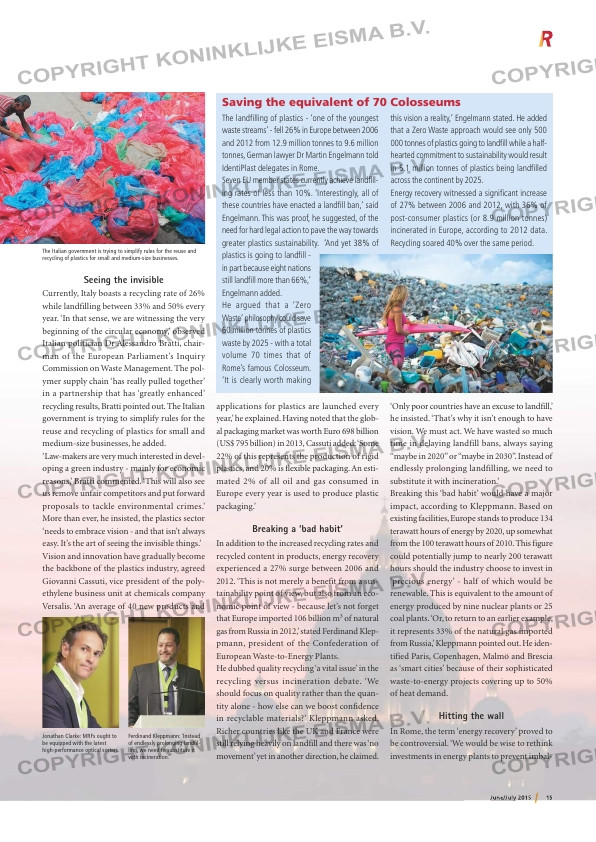Page 15 from: June / July 2015

15June/July 2015
Seeing the invisible
Currently, Italy boasts a recycling rate of 26%
while landfilling between 33% and 50% every
year. ‘In that sense, we are witnessing the very
beginning of the circular economy,’ observed
Italian politician Dr Alessandro Bratti, chair-
man of the European Parliament’s Inquiry
Commission on Waste Management. The pol-
ymer supply chain ‘has really pulled together’
in a partnership that has ‘greatly enhanced’
recycling results, Bratti pointed out. The Italian
government is trying to simplify rules for the
reuse and recycling of plastics for small and
medium-size businesses, he added.
‘Law-makers are very much interested in devel-
oping a green industry – mainly for economic
reasons,’ Bratti commented. ‘This will also see
us remove unfair competitors and put forward
proposals to tackle environmental crimes.’
More than ever, he insisted, the plastics sector
‘needs to embrace vision – and that isn’t always
easy. It’s the art of seeing the invisible things.’
Vision and innovation have gradually become
the backbone of the plastics industry, agreed
Giovanni Cassuti, vice president of the poly-
ethylene business unit at chemicals company
Versalis. ‘An average of 40 new products and
applications for plastics are launched every
year,’ he explained. Having noted that the glob-
al packaging market was worth Euro 698 billion
(US$ 795 billion) in 2013, Cassuti added: ‘Some
22% of this represents the production of rigid
plastics, and 20% is flexible packaging. An esti-
mated 2% of all oil and gas consumed in
Europe every year is used to produce plastic
packaging.’
Breaking a ‘bad habit’
In addition to the increased recycling rates and
recycled content in products, energy recovery
experienced a 27% surge between 2006 and
2012. ‘This is not merely a benefit from a sus-
tainability point of view, but also from an eco-
nomic point of view – because let’s not forget
that Europe imported 106 billion m3 of natural
gas from Russia in 2012,’ stated Ferdinand Klep-
pmann, president of the Confederation of
European Waste-to-Energy Plants.
He dubbed quality recycling ‘a vital issue’ in the
recycling versus incineration debate. ‘We
should focus on quality rather than the quan-
tity alone – how else can we boost confidence
in recyclable materials?’ Kleppmann asked.
Richer countries like the UK and France were
still relying heavily on landfill and there was ‘no
movement’ yet in another direction, he claimed.
‘Only poor countries have an excuse to landfill,’
he insisted. ‘That’s why it isn’t enough to have
vision. We must act. We have wasted so much
time in delaying landfill bans, always saying
“maybe in 2020” or “maybe in 2030”. Instead of
endlessly prolonging landfilling, we need to
substitute it with incineration.’
Breaking this ‘bad habit’ would have a major
impact, according to Kleppmann. Based on
existing facilities, Europe stands to produce 134
terawatt hours of energy by 2020, up somewhat
from the 100 terawatt hours of 2010. This figure
could potentially jump to nearly 200 terawatt
hours should the industry choose to invest in
‘precious energy’ – half of which would be
renewable. This is equivalent to the amount of
energy produced by nine nuclear plants or 25
coal plants. ‘Or, to return to an earlier example,
it represents 33% of the natural gas imported
from Russia,’ Kleppmann pointed out. He iden-
tified Paris, Copenhagen, Malmö and Brescia
as ‘smart cities’ because of their sophisticated
waste-to-energy projects covering up to 50%
of heat demand.
Hitting the wall
In Rome, the term ‘energy recovery’ proved to
be controversial. ‘We would be wise to rethink
investments in energy plants to prevent imbal-
Jonathan Clarke: MRFs ought to
be equipped with the latest
high-performance optical sorters.
Ferdinand Kleppmann: ‘Instead
of endlessly prolonging landfi l-
ling, we need to substitute it
with incineration.’
Saving the equivalent of 70 Colosseums
The landfi lling of plastics – ‘one of the youngest
waste streams’ – fell 26% in Europe between 2006
and 2012 from 12.9 million tonnes to 9.6 million
tonnes, German lawyer Dr Martin Engelmann told
IdentiPlast delegates in Rome.
Seven EU member states currently achieve landfi ll-
ing rates of less than 10%. ‘Interestingly, all of
these countries have enacted a landfi ll ban,’ said
Engelmann. This was proof, he suggested, of the
need for hard legal action to pave the way towards
greater plastics sustainability. ‘And yet 38% of
plastics is going to landfi ll –
in part because eight nations
still landfi ll more than 66%,’
Engelmann added.
He argued that a ‘Zero
Waste’ philosophy could save
60 million tonnes of plastics
waste by 2025 – with a total
volume 70 times that of
Rome’s famous Colosseum.
‘It is clearly worth making
this vision a reality,’ Engelmann stated. He added
that a Zero Waste approach would see only 500
000 tonnes of plastics going to landfi ll while a half-
hearted commitment to sustainability would result
in 5.1 million tonnes of plastics being landfi lled
across the continent by 2025.
Energy recovery witnessed a signifi cant increase
of 27% between 2006 and 2012, with 36% of
post-consumer plastics (or 8.9 million tonnes)
incinerated in Europe, according to 2012 data.
Recycling soared 40% over the same period.
The Italian government is trying to simplify rules for the reuse and
recycling of plastics for small and medium-size businesses.
RI_5-IdentiPlast.indd 15 15-06-15 12:03



